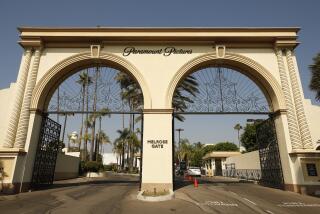Panavision’s New Owners Focus on Debt
- Share via
When a cricket batsman swings and misses, according to British slang, “he is bowled out.” Two English brothers, John and Benny Lee, have recently learned the American version of that phrase.
A year ago, the Lee brothers paid $148 million to buy Panavision, the Tarzana company that is the leading supplier of 35-millimeter cameras and accessories to the American film and TV industry. With that stroke, the Lees planned to make themselves a big name in the American movie equipment market. Instead, the Lees struck out.
Last week, a group from E.M. Warburg, Pincus & Co. a New York investment banking house, announced it intended to take over most of the Lees’ struggling company, Westward Communications, a London-based entertainment conglomerate that includes Panavision among its holdings.
Warburg, Pincus tentatively agreed to pump $60 million into the company’s cash-strained operations and will also take over Westward’s hefty $340 million in debts. The deal will close by Nov. 30, if the company’s debts can be renegotiated with Westward’s lenders, primarily Citicorp. Should the deal go through, William C. Scott, former president of Western Pacific Industries, will become chief executive of the renamed parent company, Lee Panavision International.
Debts Exceed Earnings
Still unclear is how Scott expects to make the company work when the Lee brothers could not. When the Lees bought Panavision in October, 1987, and merged it into their English company, their companies had combined annual sales of about $135 million, while debts exceeded assets by $153 million.
Warburg, Pincus has already infused $5 million into the company, and Lee Panavision spokeswoman Joan Urbaniak said it was welcome. “We had been holding vendors at bay. We had been pretty stretched out and were holding off paying expenses,” she said.
It seems likely that the new owners will have to sell some companies to help shrink the debt. Urbaniak said no decision has been made on what, if anything, would be sold, save one. “We will not sell Panavision,” she said. Panavision President John Farrand will remain in charge of the company.
The Lee brothers hope to buy from the new owners the English lighting equipment rental business they started many years ago. Besides Panavision, Lee Panavision owns two American movie equipment rental companies, Mitchell Camera and JDC America; Lee Colortran, a manufacturer of lighting equipment in the United States and Europe, plus a lighting equipment rental company called Lee America West.
Two of the most valuable assets are the company’s English film studios. Shepperton Studios is a landmark film complex that has been the site for scenes from such films as “The African Queen,” “The Guns of Navarone” and more recently “Out of Africa,” while Wembley is used primarily for television commercials. The Wembley studio has been widely rumored to be up for sale.
However Lee Panavision is rearranged, it marks the end of a dream for the Lee brothers to make a big splash in America.
The brothers started out in 1961 as small film-lighting electbicians in England and over the years steadily built their empire by acquiring small companies. Before the Lees bought Panavision, they headed a successful, publicly held English company that manufactured and rented cameras, lenses and lighting equipment for film and television productions in Europe and the United States, and turned a $6.6-million profit on sales of $90 million.
Entrance to U.S. Market
But the Lees were still small potatoes in the United States, and when they had a chance to buy Panavision, they jumped at it. They seem to have jumped too fast.
In 1985, Warner Communications had sold Panavision for about $55 million to a group headed by Frederick W. Field, a film producer and heir to the Marshall Field department store fortune. Field sold off Panavision’s headquarters building and a camera subsidiary for about $7 million.
He then sold Panavision to the Lees for $100 million cash. In addition, the Lees took over Panavision’s $48 million in debts. So the Lees paid nearly twice what Field had paid 2 years earlier, after Field had sold off some key assets.
The Lees bought a profitable company, but justifying the price they paid is another matter. In 1986, the year before the Lees bought Panavision, the company turned a $2.4-million profit on sales of $29.1 million. That means the Lees paid 61 times Panavision’s earnings. At the time the deal went through, the average price-to-earnings ratio on the stock market was 18.
Reached by telephone last week in London, Benny Lee defended the deal. “I really don’t think Panavision was too expensive,” he said.
But Manfred Klemme, western division manager in Los Angeles for Arriflex Corp., a West German camera company that is Panavision’s chief rival, disagreed. “The Lees had eyes bigger than their stomach,” Klemme said.
Financial Strain
The Panavision deal immediately caused a financial strain. The London Stock Exchange indicated it wouldn’t allow the Lees to keep their company public because of the added debt, so Citicorp loaned them $327 million to buy Panavision and to buy back the stock in their English company and take it private.
The Lees planned to chip away at their mountain of debt by taking their company public in the United States this year. But price and timing can be everything in business, and the Lees struck out on both.
Less than a week after the Lees bought Panavision, the American stock market crashed, effectively snuffing out their chance for a public offering. Meanwhile, the Office of Fair Trading in England has been investigating the Lees’ near-monopoly over the lighting-equipment rental business.
There was little margin for error for the Lees, and the 5-month writers’ strike in the United States put an untimely crimp into their cash flow.
Reason for Demise
Last week, Benny Lee wondered aloud how things went sour after the Panavision deal. “Maybe if we’d concentrated and gone in there straight away to try and streamline it, things would have been different.” Lee ticked off other reasons his empire crumbled. “The stock market went, the Office of Fair Trading and the writers’ strike.”
Milt Keslow, vice president of General Camera in New York that rents Panavision equipment, laid part of the blame for the Lees’ failure to “too many directors, too many chiefs.” Keslow said that despite the Lees’ financial troubles, Panavision is sound, and the company’s “cash flow is excellent.”
Since the writers’ strike ended, Keslow pointed out, business is white hot. His company’s Panavision rentals are running at $2 million a month, up from $500,000 a month last spring. “I if I had a Brownie camera, I could rent it out,” he said.
More to Read
The biggest entertainment stories
Get our big stories about Hollywood, film, television, music, arts, culture and more right in your inbox as soon as they publish.
You may occasionally receive promotional content from the Los Angeles Times.











